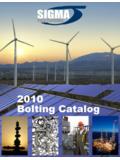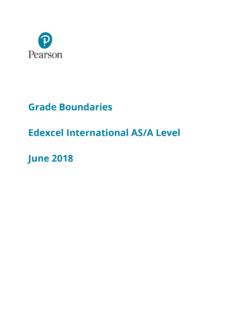Transcription of Section 22a-174-29 Hazardous Air Pollutants - Connecticut
1 NOTE This document contains the Connecticut regulations for the abatement of air pollution with the recently adopted revisions to subsection (b), which became effective April 4, 2016. This document was prepared by the State of Connecticut Department of Environmental Protection and is provided for the convenience of the reader. This is not the official version of the regulations. The official regulations are published by the State of Connecticut , Judicial Branch, Commission on Official Legal Publications in the Connecticut Law Journal. Official legal publications may be obtained from the Commission on Official Legal Publications, 111 Phoenix Ave Enfield, CT 06082 (telephone: (860) 741-3027, or ). In the event there is an inconsistency between this document and the regulations as published in the Connecticut Law Journal, the Connecticut Law Journal will serve as the official April 4, 2016 Page 29-1 Section 22a- 174- 29.
2 Hazardous Air Pollutants (a) Hazard Limiting Values and Ambient Air Quality Standards (a)(1) Hazard Limiting Values (HLV)'s for Hazardous Air Pollutants for 8-hour and 30- minute averaging times are listed in Tables 29-1, 29- 2, and 29- 3. Ambient Air Quality Standards (AAQS) are listed in Section 22a -174 -24. (a)(2) For a Hazardous air pollutant or other air pollutant for which either a HLV or an AAQS has not yet been established by the Commissioner, the Commissioner may request the Commissioner of Health Services to propose changes to Tables 29- 1, 29- 2 or 29-3 or to Section 22a-174- 24, to provide supporting documentation for his selection, and to submit it for review by the Hazardous Air pollutant Advisory Panel within ninety (90) days of receipt of the request of the Commissioner. (a)(3) The Commissioner shall request the Panel to review the proposal and supporting documentation and to make a recommendation to the Commissioner to approve, modify or decline to accept the proposal within ninety (90) days of receipt.
3 Within sixty (60) days of receipt of the recommendation of the Panel, the Commissioner shall announce a hearing for a new HLV to be included in Tables 29- 1, 29-2, or 29-3 or AAQS for Section 22a- 174-24. (b) Maximum Allowable Stack Concentrations. (1) On or after October 1, 1986, no person shall cause or permit the emission of any Hazardous air pollutant listed in Table 29- 1 from any stationary source at a concentration at the discharge point in excess of the maximum allowable stack concentration, unless the stationary source is operating in accordance with the terms of an order or permit of the commissioner specifically allowing the continued operation of the stationary source in violation of this subdivision while coming into compliance or the source is in compliance with the provisions of subsection (d)(3) of this Section . (2) No person, who is required to maintain compliance with a permit under Section 22a-174- 3a of the Regulations of Connecticut State Agencies shall cause or permit the emission of any Hazardous air pollutant listed in Table 29-1, 29-2 or 29- 3 of this Section from any stationary source or modification at a concentration at the discharge point in excess of Effective April 4, 2016 Page 29-2 the maximum allowable stack concentration unless such source is in compliance with the provisions of subsection (d)(3) of this Section .
4 The owner or operator of a stationary source who was issued a permit under former Section 22a-174 -3 of the Regulations of Connecticut State Agencies prior to July 1, 1986 shall be required to comply with Tables 29-2 and 29-3 of this Section upon modification of such permit. (3) If the owner or operator of a stationary source that emits or may emit a Hazardous air pollutant is in compliance with the MASC at the discharge point of that source, but the commissioner determines, through ambient monitoring, that the HLV is exceeded, then the commissioner may require that the concentration of the Hazardous air pollutant at the discharge point be further reduced. (4) The owner or operator of any stationary source or modification not subject to the provisions of subdivision (2) or subdivision (6) of this subsection that emits or may emit a Hazardous air pollutant shall comply with the requirements of subdivision (2) of this subsection if the commissioner determines, through ambient monitoring, that the HLV is exceeded as a result of the emissions from that stationary source.
5 (5) For the purposes of subdivisions (3) and (4) of this subsection, any person who performs ambient air monitoring shall use methods and procedures approved by the commissioner. (6) The owner or operator of any incinerator shall not cause or permit the emission of any Hazardous air pollutant listed in Table 29-1, 29-2 or 29-3 of this Section from such incinerator at a concentration at the discharge point in excess of the maximum allowable stack concentration. (c) Determination of Maximum Allowable Stack Concentrations (c)(1) The maximum allowable stack concentration of a Hazardous air pollutant (in micrograms per cubic meter or parts per million) at the discharge point of a stationary source shall be determined as follows: (A) If the discharge point is twenty (20) meters or less measured vertically from the ground elevation at the discharge point, the MASC shall be: HLV (X +.)
6 64) [1] V0 Effective April 4, 2016 Page 29-3 Where HLV is the applicable hazard limiting value (in either micrograms per cubic meter or parts per million for 8-hour and 30- minute averaging times), V0 is the average actual flow rate (in actual cubic meters per second) from the discharge point, and X is ten (10) meters, or the distance from the discharge point to the closest property line, whichever is greater. (B) If the discharge point is more than twenty (20) meters measured vertically from the ground elevation at the discharge point, the maximum allowable stack concentration ( MASC ) shall be: (x max + ) exp[ (H V0 - 20)2(x max + ) ] [2] Where HLV is the applicable hazard limiting value (in micrograms per cubic meter or parts per million) for 8-hour and 30- minute averaging times, V0 is the average actual flow rate (in actual cubic meters per second) from the discharge point, H is the height (in meters) of the discharge point , measured vertically from the ground elevation at the discharge point and Xmax is the greater of the following distances: (i) ten (10) meters (ii) the closest distance, in meters, from the discharge point to the property line, or (iii) the distance, in meters, determined by.
7 (H - 20) [3] Where H is the height (in meters) of the discharge point measured vertically from the ground elevation at the discharge point. (c)(2) For the purposes of this subsection, in determining the distance from the discharge point to the property line the Commissioner may allow consideration for any watercourse adjacent to the property in question. The Effective April 4, 2016 Page 29-4 Commissioner may allow the use of the opposite shore in determining the closest distance to the property line. (d) Ambient Air Quality Standards. (1) The provisions of this subsection apply to any stationary source that emits an air pollutant for which there is an ambient air quality standard ("AAQS") found in Section 22a-174-24 of the Regulations of Connecticut State Agencies except for any criteria air pollutant other than lead. (2) If the source complies with the MASC and there is an applicable AAQS, then the owner or operator shall not cause or exacerbate a violation of the applicable AAQS unless the impact of the source is less than significant as listed in Table 3a(i)-1 set forth in Section 22a-174 -3a(i) of the Regulations of Connecticut State Agencies.
8 (3) If the source does not comply with the MASC and there is an applicable AAQS, then the owner or operator shall: (A) Install and use Best Available Control Technology for the applicable Hazardous air pollutant ; and (B) Not cause an impact in excess of the applicable AAQS if such impact is significant as listed in Table 3a(i)-1 set forth in Section 22a-174 -3a(i) of the Regulations of Connecticut State Agencies. (4) Upon the request of the commissioner, the owner or operator of any stationary source shall make and submit to the commissioner, for his approval, a BACT determination for each Hazardous air pollutant for which an AAQS has been set, as required by the commissioner, including costs estimates of all control options as may be specified by the commissioner. (5) For the purposes of this subsection, the commissioner shall allow the use of only air quality models, data bases or other requirements approved by the commissioner prior to the determination of compliance with the AAQS.
9 (e) Sampling for Hazardous Air Pollutants . (1) Testing to determine concentrations of Hazardous air Pollutants in the ambient air contiguous to a source may be required if the commissioner determines that the operation of a source might reasonably be expected to cause an exceedance of an applicable HLV or AAQS. (2) In addition to any testing required by Section 22a -174- 5(e)(2) of the Regulations of Connecticut State Agencies, testing to determine concentrations of Hazardous air Pollutants at discharge points of sources may be required by the commissioner Effective April 4, 2016 Page 29-5 if: (A) An exceedance of a HLV with an 8-hour averaging time is observed; (B) Two (2) or more exceedances of a HLV with a 30 -minute averaging time are observed within two (2) non- overlapping 8- hour periods within any seven (7)-day period; (C) The source is required to meet the requirements of subdivision (b)(2) of this Section ; (D) The emissions from a source are suspected of causing a violation of an AAQS; (E) There is an enforcement action for violation of Section 22a-174 -20 or 22a-174 -23 of the Regulations of Connecticut State Agencies.
10 Or (F) The source is suspected of emitting a Hazardous air pollutant listed in Table 29-1. (3) Testing to determine concentrations of Hazardous air Pollutants at either discharge points of stationary sources or in the ambient air shall be conducted by the commissioner, the commissioner s authorized representative or by persons qualified by training or experience in the field of sampling emissions from air pollution sources or in the ambient air. All sampling, emissions testing and laboratory analyses shall be done using procedures and techniques approved by the commissioner prior to the commencement of such testing. (4) In addition to the provisions of subdivision (1) of this subsection, the commissioner shall perform testing for dioxin emissions in the ambient air in accordance with the requirements of this subdivision. The commissioner shall perform the following tests in the area of any resources recovery facility. The tests shall be representative of conditions existing prior to the commencement of operation and representative of conditions existing after the issuance of the permit to operate.











![1[SCHEDULE VI] - Central Pollution Control Board](/cache/preview/d/6/4/6/4/2/4/9/thumb-d6464249d79972a2e804a0aa4573c697.jpg)






